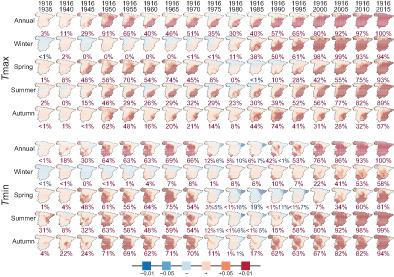当前位置:
X-MOL 学术
›
Int. J. Climatol.
›
论文详情
Our official English website, www.x-mol.net, welcomes your feedback! (Note: you will need to create a separate account there.)
Seasonal temperature trends on the Spanish mainland: A secular study (1916–2015)
International Journal of Climatology ( IF 3.9 ) Pub Date : 2021-01-12 , DOI: 10.1002/joc.7006 Dhais Peña‐Angulo 1 , José Carlos González‐Hidalgo 2, 3 , Leire Sandonís 2, 3 , Santiago Beguería 4 , Miquel Tomas‐Burguera 4 , Joan Albert López‐Bustins 5 , Marc Lemus‐Canovas 5 , Javier Martin‐Vide 5
International Journal of Climatology ( IF 3.9 ) Pub Date : 2021-01-12 , DOI: 10.1002/joc.7006 Dhais Peña‐Angulo 1 , José Carlos González‐Hidalgo 2, 3 , Leire Sandonís 2, 3 , Santiago Beguería 4 , Miquel Tomas‐Burguera 4 , Joan Albert López‐Bustins 5 , Marc Lemus‐Canovas 5 , Javier Martin‐Vide 5
Affiliation

|
Trends in seasonal mean values of maximum and minimum temperature are analysed in the Spanish mainland from the new MOTEDAS_century database. This new data set has been developed combining the digitalized archives from the Spanish Meteorological Agency (AEMET) with information retrieved from Annual Books published by the former Meteorological Agency dating back to 1916, and covers the period 1916–2015. In all four seasons, mean seasonal temperature of maximum (Tmax) and minimum (Tmin) increased. The raising occurred in two main pulses separated by a first pause around the middle of the 20th century, but differed among seasons and also between maximum and minimum temperature. Analysis of the percentage of land affected by significant trends in maximum temperature reveals two increasing phases in spring and summer for Tmax, and in spring, summer, and autumn for Tmin. However, winter Tmax only rose during the recent decades, and autumn Tmax in the first decades. Negative significant trends were found in extended areas in spring Tmax, and in spring, autumn, and summer Tmin, confirming the first pause around the 1940's–1960's. Trends of seasonal mean values of Tmax and Tmin are not significant for at least the last 25–35 years of the study period, depending on the season. The areas under significant positive trend are usually more extended for Tmin than Tmax at any season and period. Areas with significant trend expand and contract in time according to two spatial gradients: south‐east to north‐west (east‐west) for Tmax, and west to east for Tmin. We hypothesize a relationship between atmospheric prevalent advection and relief as triggering factors to understand spatial and temporal differences in seasonal temperatures at regional scale during the 20th century in the Iberian Peninsula.
中文翻译:

西班牙大陆的季节性温度趋势:一项长期研究(1916年至2015年)
通过新的MOTEDAS_century数据库在西班牙大陆分析了最高和最低温度的季节性平均值趋势。这个新的数据集是结合了西班牙气象局(AEMET)的数字化档案和从1916年至1916年的前气象局出版的《年鉴》中检索到的信息而开发的。在所有四个季节中,最高(T max)和最低(T分钟)增加。上升发生在两个主要脉冲之间,在20世纪中叶左右被第一次停顿隔开,但在各个季节之间以及最高和最低温度之间有所不同。对受最高温度显着趋势影响的土地百分比的分析表明,春季和夏季的T max分别为两个增加阶段,而春季,夏季和秋天的T min为两个增加阶段。但是,冬季T max仅在最近几十年内上升,而秋季T max在前几十年内。在春季的T max以及春季,秋季和夏季的T min的扩展区域中发现了负的显着趋势,证实了1940年代至1960年代的第一次停顿。季节性平均值的趋势至少在研究期的最后25-35年内,T max和T min并不重要,具体取决于季节。在任何季节和任何时期,具有明显正趋势的区域通常在T min范围内比在T max范围内扩展。趋势显着的区域会根据两个空间梯度在时间上扩展和收缩:T max从东南到西北(东西),T min从西到东。我们假设大气普遍对流与释放之间的关系是了解伊比利亚半岛20世纪区域尺度季节性温度时空差异的触发因素。
更新日期:2021-01-12
中文翻译:

西班牙大陆的季节性温度趋势:一项长期研究(1916年至2015年)
通过新的MOTEDAS_century数据库在西班牙大陆分析了最高和最低温度的季节性平均值趋势。这个新的数据集是结合了西班牙气象局(AEMET)的数字化档案和从1916年至1916年的前气象局出版的《年鉴》中检索到的信息而开发的。在所有四个季节中,最高(T max)和最低(T分钟)增加。上升发生在两个主要脉冲之间,在20世纪中叶左右被第一次停顿隔开,但在各个季节之间以及最高和最低温度之间有所不同。对受最高温度显着趋势影响的土地百分比的分析表明,春季和夏季的T max分别为两个增加阶段,而春季,夏季和秋天的T min为两个增加阶段。但是,冬季T max仅在最近几十年内上升,而秋季T max在前几十年内。在春季的T max以及春季,秋季和夏季的T min的扩展区域中发现了负的显着趋势,证实了1940年代至1960年代的第一次停顿。季节性平均值的趋势至少在研究期的最后25-35年内,T max和T min并不重要,具体取决于季节。在任何季节和任何时期,具有明显正趋势的区域通常在T min范围内比在T max范围内扩展。趋势显着的区域会根据两个空间梯度在时间上扩展和收缩:T max从东南到西北(东西),T min从西到东。我们假设大气普遍对流与释放之间的关系是了解伊比利亚半岛20世纪区域尺度季节性温度时空差异的触发因素。



























 京公网安备 11010802027423号
京公网安备 11010802027423号